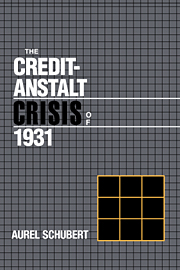Book contents
- Frontmatter
- Contents
- Tables
- Preface
- The Credit-Anstalt Crisis of 1931
- 1 Introduction
- 2 Diary of the crisis
- 3 Financial crisis theories and the Austrian experience of 1931
- 4 The causes of the financial crisis
- 5 The financial crisis and market efficiency
- 6 The financial crisis and economic activity
- 7 The financial crisis and the lender of last resort
- 8 Alternative policies and policy implications
- 9 Conclusions
- Bibliography
- Index
9 - Conclusions
Published online by Cambridge University Press: 20 March 2010
- Frontmatter
- Contents
- Tables
- Preface
- The Credit-Anstalt Crisis of 1931
- 1 Introduction
- 2 Diary of the crisis
- 3 Financial crisis theories and the Austrian experience of 1931
- 4 The causes of the financial crisis
- 5 The financial crisis and market efficiency
- 6 The financial crisis and economic activity
- 7 The financial crisis and the lender of last resort
- 8 Alternative policies and policy implications
- 9 Conclusions
- Bibliography
- Index
Summary
History can repeat itself – with a vengeance.
–Henry KaufmanThe crisis of the Austrian Credit-Anstalt in 1931 is an interesting case study of a financial crisis with repercussions going far beyond the Austrian borders. The collapse of this bank opened the acute phase of the crisis, which shook the world economy to its foundations during the second half of 1931. The key areas covered by this study were (1) the analysis of the crisis in the context of leading theories of financial crises, (2) the identification of the causes of each stage of the crisis, (3) the examination of the market's efficiency in predicting the crisis, (4) the analysis of how the crisis was transmitted to the Austrian macroeconomy, (5) the study of the behavior of the authorities as lenders of last resort during the crisis and how their behavior shaped events, and, finally, (6) the identification of policy recommendations resulting from the events of 1931, which are still valid sixty years after the crisis. The comparison of the events in Austria with the three leading theoretic approaches to financial crises revealed that, for all the theories, the episode constituted a true financial crisis and not a pseudocrisis.
The financial distress of the Credit-Anstalt started this financial crisis with a short-lived run on the banking sector and a subsequent attack on the Austrian currency. The problems of the largest Austrian bank were caused by a plethora of reasons, and the banking panic by perceived similarities among the Viennese banks, but the currency crisis was a reaction to the way the initial episodes were handled.
- Type
- Chapter
- Information
- The Credit-Anstalt Crisis of 1931 , pp. 185 - 190Publisher: Cambridge University PressPrint publication year: 1992



